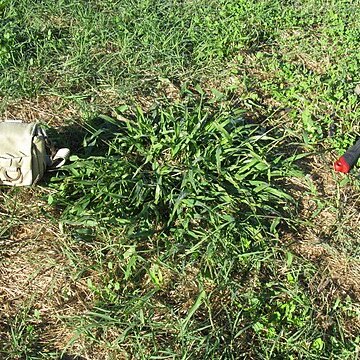Tufted perennial 200-1 500 mm high; stoloniferous, sometimes rooting and branching from lower nodes; basal sheaths glabrous to densely hairy, usually not splitting into fibres. Leaf blade 20-300 x 3-20 mm. Inflorescence of (2)3-15 racemes, 20-80 mm long. Spikelet 3-5 mm long, ovate; lower glume 2/3-5/6 as long as spikelet, 3-nerved, 1-3 stiff hairs on the back, apex broadly rounded; upper glume 5-nerved, usually without cross-veins, glabrous or pubescent; lower lemma with or without a fringe of stiff hairs near the margins; upper lemma awn well developed, 0.5-1.2 mm long; anther 1-2 mm long.
Perennial, stoloniferous and tufted (sometimes rooting and branching from lower nodes), up to 1.5 m high. Leaf blades 20-300 mm long, 3-20 mm wide. Basal sheaths glabrous or hairy, usually not splitting into fibres. Spikelets 3-5 mm long. Racemes (2-)3-15, 20-80 mm long; lower glume 3-nerved with 1-3 stiff hairs on back; awn of upper lemma well developed, 0.5-1.2 mm long.
Perennial; up to 1.5 m high; stoloniferous; tufted. Leaf blades 20-300 x 3-20 mm; basal sheaths glabrous or hairy; usually not splitting into fibres. Flowers: in spaced; digitate inflorescences; racemes (2)3-15; 20-80 mm long; spikelets 3-5 mm long; lower glume 3-nerved with 1-3 stiff hairs on back; upper glume 5-nerved; awn of upper lemma well developed; 0.5-1.2 mm long.
A grass. It keeps growing from year to year. It grows 1 to 1.3 m high. It forms tufts. The leaves are broad and have a sharp point. The flowering shoots consist of 4 to 10 dense, one-sided spikes. These are grey and are near the tip of the stems. The spikelets are 5 mm long.
Inferior glume 2/3–5/6 length of spikelet, elliptic-oblong, 3–nerved, slightly cartilaginous and shiny, often with a tuft of hairs from middle of back. Superior glume usually without cross-nerves.
Inflorescence of 3–20 racemes, these 1–14 cm. long, bearing usually single spikelets on a narrowly winged rhachis.
Spikelets 2.5–5.5 mm. long, ovate, glabrous, pubescent or setosely fringed, acuminate sometimes to a subulate tip.
Inferior lemma usually without cross-nerves. Superior lemma granulose to rugulose, with a macro 0.5–1.2 mm. long.
Tufted or stoloniferous perennial, the basal sheaths silky pubescent.
Leaf laminae broadly linear, ± hispid.
Culms 20–170 cm. high, ascending.

